In recent weeks I’ve had a number of people message me asking if they should pick up Death’s Shadow for their next event. My answer is almost universally, “Probably not.”
It isn’t because Death’s Shadow is impossible to play; or because I don’t want to see people win; or even that I don’t think people are strong enough Magic players to succeed. It’s largely due to having to understand one of Magic’s key, but underused principles: how to use your life total as a resource, but on a much deeper level than most people do.
But in order to help fix that situation, I’ve decided to write this guide to Mardu Death’s Shadow, which not only explains how that concept applies to it, but also goes into depth about the theory, card choices, and gameplay of the deck.
Core Principles
Life Total Management
Life total management is arguably one of the hardest skills when piloting any deck, but is extra important in any Death’s Shadow deck and it is also the concept that I see applied incorrectly the most often.
Learning this one can be difficult because there aren’t hard and fast rules that can tell you what to do. Life total management is a skill that is developed while playing because you need to be able to gauge how aggressively your opponent aims to play the game. Sometimes you’re controlling the pace of the game by being the aggressor and your opponent needs to keep pace with you This is often the case against decks like Tron and Azorious Control, where you need to go fast or the opposing deck isn’t adept at pressuring your life total.
However, in aggressive matchups like Burn and Phoenix, you need to be thinking multiple turns ahead about small things, like how many times you can use Silent Clearing before it will place you in danger. Knowing when to fetch basics or tapped shocks is another line I often see blurred. This is usually dictated by matchups where you know you need to preserve your life total, but newer pilots will be overzealous about taking damage to enable Death’s Shadow.
My biggest piece of advice is that leveraging your life total is that it’s not always a race to the bottom but rather a balancing act between your opponent’s aggression and your ability to apply pressure.
Turning the Corner
Turning the corner refers to the point in the game where you’ve broken parity and have pulled ahead and need to finish the game before your opponent can get themselves back into things. This is more of a general midrange principle than a Mardu Shadow-specific one.
I find that with Death’s Shadow the window to turn is often smaller than with other decks due to the balancing act we have to play with our life total. For Mardu Shadow, this can happen rather abruptly because drawing another removal spell, Death’s Shadow, or Temur Battle Rage can change the look of the battlefield drastically. Suddenly your opponent doesn’t have a lethal attack once you’ve dealt with one of their creatures and can start getting busy with Death’s Shadow. This often results in your opponent trying to block and race you back, which can end quite poorly for them if you have any of the previously mentioned cards.
A traditional midrange deck, like Jund, has a larger window because they often start in a more stable boardstate with a higher life total. Mardu Shadow starts this process around seven life so you have to pick your turn carefully and go, because it doesn’t take more than one mistake for your opponent to turn your plan upside down.
Creating a Mana Advantage
One of the bigger strengths of any Death’s Shadow strategy is creating and leveraging a mana advantage.
Just looking at the curve of the deck, you can see that we prioritize playing one- and two-mana spells, which has a couple of benefits. First it lets the deck get away with playing a lower land count than most decks, and significantly less than other midrange decks. Where most midrange decks play between 23 to 25 lands, Mardu Shadow plays just 19. This naturally gives us room to play a wider variety of spells, giving us more options in more matchups. Playing a lower curve than most decks in Modern also lets us play multiple spells in the same turn before our opponent can, which is similar to getting small pieces of an extra turn.
Creating a mana advantage can also be obtained by trading cheaper cards with our opponent’s more expensive cards. A good example of this is trading our Fatal Push with our opponent’s Tarmogoyf. We can capitalize on this by casting a second spell during our turn, creating a mana advantage because we were able to negate our opponent’s entire turn while still progressing our game plan. However, this mana advantage can’t be leveraged forever. As games go longer and our opponents start casting multiple spells per turn, too, it is possible that their more expensive spells will start to overpower ours. Make sure you do everything to capitalize on these advantages while you have them.
The Deck List
Modern Mardu Death's Shadow
| Creatures (18) 4 Death's Shadow 1 Gurmag Angler 1 Hex Parasite 4 Ranger-Captain of Eos 4 Street Wraith 4 Tidehollow Sculler Spells (17) 2 Inquisition of Kozilek 4 Thoughtseize 2 Unearth 2 Fatal Push 1 Dismember 4 Path to Exile 2 Temur Battle Rage Artifacts (6) 4 Mishra's Bauble 2 Nihil Spellbomb | Lands (19) 2 Arid Mesa 1 Blood Crypt 3 Bloodstained Mire 2 Godless Shrine 4 Marsh Flats 1 Sacred Foundry 4 Silent Clearing 1 Snow-Covered Plains 1 Snow-Covered Swamp Sideboard (15) 2 Celestial Purge 2 Collective Brutality 1 Kolaghan's Command 4 Leyline of the Void 1 Liliana of the Veil 1 Liliana, the Last Hope 2 Plague Engineer 1 Wear//Tear 1 Shenanigans |
I’ve only made very slight changes to my MCQ winning list. I wanted a Shenanigans over one of the Wear // Tear to supplement the Urza matchup. Dismember over a Fatal Push is the other change, which helps enable early Death’s Shadows a little more often. You could consider a third copy of Collective Brutality if you expect a lot of basic Mountains.
Let’s take a look at what makes the deck tick.
Key Cards
Threats
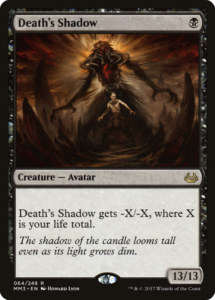
Most builds of Death’s Shadow have around eight solid threats backed up with some utility creatures. First and foremost, we have the deck’s namesake, Death’s Shadow. We have to jump through some hoops to be able to play such an efficient threat, but trust me, it’s worth it. Having access to a one-mana creature that is often between a 4/4 and a quickly a 10/10 is incredibly under-costed.
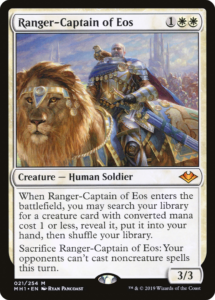
Ranger-Captain of Eos is our other primary threat. You might look at this card and wonder how a three mana 3/3 is supposed to be a real threat. Well, that three mana 3/3 has a lot of words on it, and if I’ve learned anything about cards with a lot of words on them, they’re usually better than cards with fewer words! On a more serious note, Ranger having a relevant body that tutors a Death’s Shadow and protects both us and our other creatures is big game, and until then Ranger can still get busy in the red zone.
A common play pattern with the deck is to clear the way on Turns 1 and 2 with discard and removal spells then stick a Death’s Shadow on turn three. Following up this play with a Turn 4 Ranger-Captain of Eos and the Death’s Shadow it finds really puts the screws to the opponent. The squeeze gets even tighter when sacrificing Ranger-Captain in the opponent’s upkeep to protect your Shadows from something like a Supreme Verdict, or even just blanking the turn your opponent needed to kill you before the Death’s Shadows finish the job.
Utility Creatures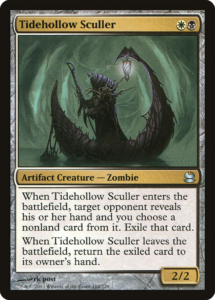
Tidehollow Sculler is a weird inclusion in most competitive Modern decks, and trust me, Mardu Death’s Shadow is no different. Aren’t we already playing six discard spells? Why do we want a 2/2 that temporarily takes something from our opponent’s hand?
The answer is actually pretty easy: the Sculler forces action. Against decks like Jund and Azorious Control, where having your Death’s Shadow killed is a big deal, Tidehollow Sculler does a great Spellskite impression. Either your opponent has to use their removal spell before the Tidehollow Sculler resolves or they lose the spell until they draw a way to deal with Sculler. Either way, your Shadow is safer for your trouble.
So why don’t we just play Spellskite? Against decks like Tron, Urza, and other low removal decks, Tidehollow Sculler is just a discard spell strapped to a Grizzly Bear. The unassuming little zombie doesn’t do anything particularly well, and isn’t flashy, but it does do all the things that we ask it to do.
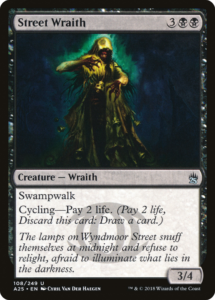
Street Wraith is a Death’s Shadow staple. Rarely cast and frequently cycled, Street Wraith effectively lets us register a smaller deck and provides an outlet to lose life at no cost.
It is one of the more nuanced cards in the deck while also looking incredibly straightforward at the same. One of the most common mistakes I see newer Death’s Shadow pilots make is to cycle Street Wraith without a reason to do so. That being said, you should have a reason for everything you do in a game of Magic, but Street Wraith represents a lot of potential things in your hand. Holding onto your Wraith can represent a combat trick and your opponent has to wonder if their block is safe or if Death’s Shadow going to suddenly grow and eat their creature? Are you making a bluff attack? Are they dead to Temur Battle Rage if you have a Street Wraith?
These are all questions your opponent has to answer on every attack if you hold onto your Wraiths until you have a reason to cycle them. Like most things in Magic, it benefits you to wait until you have the most information possible before making an action.
Squeezing extra value out of your Mishra’s Bauble is another good reason to hold onto a Wraith. Cracking a Bauble targeting yourself with access to a fetch land and a Street Wraith gives you the ability to draw the card you see from the Bauble right away or shuffle it away with the fetch land to prevent drawing a card you don’t want. This trick actually means a lot more in Grixis Death’s Shadow since it can play cantrips, but it is still best to get the most value possible out of your cards whenever you can.
Granted, if you have a real reason to cycle, do it! I’ll often cycle when I’m looking for a certain type of card on a specific turn. A discard spell on turn one is a great example. Sometimes you simply need to lose two more life to get a Death’s Shadow in play.
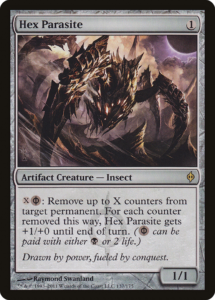
Hex Parasite is another strange card that you don’t expect to see in Modern decks, but here it is. Let me tell you this little guy almost didn’t make my list because of how the card looks on its face, but wow, did it impress!
I’ve previously described this card as a Temur Battle Rage you can tutor for, but in reality it’s more than that. Digging up a Hex Parasite with Ranger-Captain of Eos opens a lot of doors. Maybe you’re playing against Humans and you get to eat the counters off of their Aether Vial. Did your opponent play a Liliana of the Veil to kill one of your creatures? No problem if you follow up with Parasite and for a total of two mana and two life, the Liliana is gone.
The beating this card puts on Hardened Scales is no joke either. If you stick this early in the game they have a really tough time getting the ball rolling. It functions very similarly to a repeated edict against Arcbound Ravager, a card that removal heavy midrange decks can struggle with otherwise.
However, all of those things are just what the card says it does. It also turns Death’s Shadow into The Abyss since it’s a free life-loss engine, but it can even put you ahead in games where you’re interested in drag racing. Adding a Hex Parasite to the battlefield with a Death’s Shadow makes your opponent constantly respect the threat of a huge attack, making them play scared that at a moment’s notice you can tank your own life total to potentially just kill them.
That is a LOT of value from a one mana creature, and I’m sorry I ever doubted the little guy.
Disruption
Discard Spells
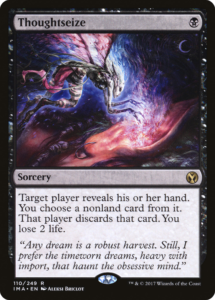
Thoughtseize and Inquisition of Kozilek are in the DNA of Black midrange decks in Modern, and this deck is no different. While decks like Jund opt for a 4/2 split favoring Inquisition, we have different needs. Thanks to Death’s Shadow we turn the life loss drawback into part of our game plan, and as such want a full four copies of the multi-format all-star.
One of the hardest parts about Magic is trying to decipher hidden information. What could our opponent have? What is their plan? Thoughtseize and Inquisition gives us the answer to those questions, while disrupting our opponent and enabling Death’s Shadow and Gurmag Angler. There can be books written about how to play these one mana spells properly, but a few short guidelines are:
- Take the card you can’t beat. A good example is something like a Scapeshift.
- Take the card that provides the most value. This fits cards like Snapcaster Mage.
- Take the card that throws off your opponent’s curve. This might be a one-drop on the play, or a two-drop on the draw.
- Save the discard spell to force a threat through either a counterspell or a removal spell.
- Wait until the turn before your opponent can cast the card you’re most afraid of to be most likely to hit it.
Removal Spells
There are two easy ways to be reactive in Magic: counterspells and removal spells. Since we don’t have access to counterspells, we have to lean hard on removal spells to both protect ourselves and clear the way to attack the opponent. Mardu Shadow tends to feature about seven removal spells in its current iteration, but that number could be more if the format gets to a place where we don’t have to maindeck graveyard hate.
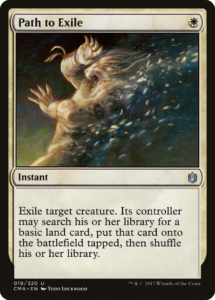
Path to Exile is a HUGE draw to the deck right now, and the card is criminally underplayed across the format. One of the reasons Mardu Shadow is successful is the positive Hogaak matchup, and this is in no small part due to packing four copies of Path to Exile in the main deck. Ringing in at just a single White mana, I’m already interested. As a removal spell that exiles in a format with no shortage of recursive graveyard threats, I’m sold.
I believe the major reason behind Path being underrepresented in the format was the lack of a strong shell for the card. Mardu Shadow is able to leverage the card perfectly. It is extremely efficient, which is right on brand, but this deck also has to ability to compact games by applying incredible pressure which mitigates the drawback of giving your opponent a land.
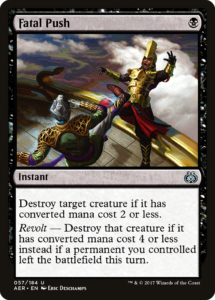
Fatal Push remains one of the most impactful printings to come into Modern in recent memory. A cheap, flexible Black removal spell is exactly what Death’s Shadow is looking for. Limiting Fatal Push to just two copies is almost exclusively due to Hogaak, otherwise there is a good chance the Path to Exile/Fatal Push split would look much different. However, I am still quite happy to be able to deal with small, and even medium sized creatures at low cost, which is something that Mardu Shadow is absolutely in the market for.
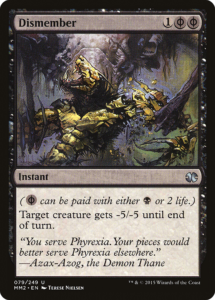
The last removal spell in the list is Dismember, a longtime staple that had fallen out of favor in early versions of Mardu but has recently returned. Dismember functions similarly to Fatal Push by being cheap and flexible. What also Dismember brings to the table is the ability to lose four life as early as Turn 1 while keeping the board clean. This spot was originally a third copy of Fatal Push, but with the fast nature of Modern I wanted one more way to enable an early Death’s Shadow, and Dismember absolutely fits the bill.
The Rest
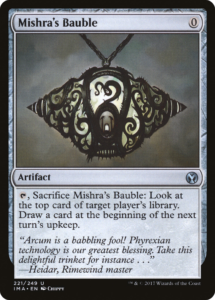
Mishra’s Bauble is another Death’s Shadow mainstay and may actually be more valuable in this version than it is in Blue versions of the deck, since we have more of a need for library manipulation.
Zero mana on any card has the potential to be powerful. It is even more powerful when it gives you any amount of extra information and draws a card. In a deck with Street Wraith and fetch lands you can really get the most out of Bauble by using its ability as pseudo-scry. It is often reasonable to target your opponent with Bauble if you don’t have a fetch but are about to play a discard spell in order to get a little more information about what their next turn looks like. Bauble tricks and sequencing are important to maximizing your win percentage.
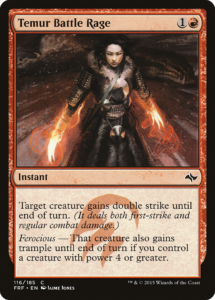
Temur Battle Rage is a powerful tool that everyone knows from the Grixis Shadow days. It serves the same functions here. Need to go fast? Battle Rage ‘em. Need to beat those pesky blockers? Battle Rage ‘em. I mostly wanted to mention TBR because I’ve heard talk of Esper and Abzan Shadow, and even talks of people cutting them in Mardu, and I think that playing Death’s Shadow without access to a Modern-legal Berserk is a mistake. Temur Battle Rage steals games by giving you the ability to win games you would otherwise have no business winning. Play two copies.
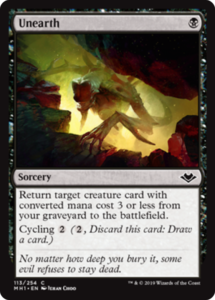
Unearth is the last card in the main deck I want to talk about. What can’t this card do? It reanimates every creature in the deck outside of Street Wraith and the single Gurmag Angler. It often acts as Death’s Shadow 5-6, but really goes to work when it picks up Ranger-Captain of Eos, which then gets you another Death’s Shadow! Unearth looks a lot like a discard spell when you have a Tidehollow Sculler in the bin. Don’t have anything in the yard to pick up? No worries, Unearth also cycles to help find action. I am incredibly happy to have two copies in the deck as is, and possibly more in the future if the meta lands in a more interactive place.
Sideboard Construction
Sideboard composition is going to fluctuate on a week by week basis, so I want to cover how this specific sideboard functions.
One question I have been getting a lot of is why I have no copies of Fulminator Mage in the sideboard. The answer is twofold. First, I don’t think big mana is popular enough to warrant narrow slots to. Second, I don’t think that the two copies of Fulminator Mage that I see in other lists are impactful enough in the matchups you want them in anyway. You won’t see them reliably enough and early enough for them to make a real difference. I have instead opted to play two copies of Collective Brutality to gain some extra ground on the basic mountain decks, as it is often one of the most powerful cards in those games.
Graveyard Hate
Well well well, it is finally time to talk about the elephant in the room: Hogaak, Arisen Necropolis. This pesky Modern Horizons card not only has us playing two copies of Nihil Spellbomb in the main deck, but also a full four Leyline of the Void in the sideboard. Leyline is the choice simply because it has the correct mix of power and speed. I believe Rest in Peace to be too slow to handle Hogaak in most games, especially on the draw. By extension, Celestial Purge serves as extra hate, being there primarily for Hogaak and Arclight Phoenix.
Artifact and Enchantment Removal
Shenanigans, Wear // Tear, Kolaghan’s Command, and to some degree Celestial Purge. The removal is varied here and a lot of it has cross applications in other spots.
Shenanigans was a late add and is here mostly in part due to the rise of the Urza deck, where multiple shatters could be needed to clear out extra Chalice of the Void and Ensnaring Bridge. Wear // Tear covers both bases, and granted there aren’t many enchantments you want to kill in Modern right now, Aria of Flame is a PROBLEM for Mardu Shadow, so having an extra answer for it is nice. Kolaghan’s Command is probably the most versatile Shatter Modern has seen. With three other relevant modes Kolaghan’s Command is a sideboard staple being good against both the artifact decks and an excellent tool to grind out the fair decks. Celestial Purge also hits some ancillary enchantments like Blood Moon and Aria of Flame that can be problematic to our plan.
Creature Removal
Small creature strategies can be among the more difficult things for Death’s Shadow decks to keep up with, so we’ve bolstered those matchups with Collective Brutality, Liliana of the Veil, Liliana, the Last Hope, and Plague Engineer.
Collective Brutality’s specialty is killing Red things, but it’s versatile enough that I’ll often bring it in against most Aether Vial decks, too. Liliana of the Veil doesn’t typically shine against decks with a ton of creatures, but with the amount of removal Mardu Shadow has access to, she does a good enough job. Liliana, the Last Hope, on the other hand, does a great job at cleaning up small creatures, while being a great way for us to recur our threats. Plague Engineer is likely the best card you can have against any of the Aether Vial decks, whether it be Humans, Spirits, or even Goblins. Engineer is going to be quite scary for the pilots of tribal decks unless they find new ways to adapt.
Hopefully this builds on last week’s article where I gave an overview of the deck to help pilots, new and old, gain a better understanding of the inner workings of Mardu Shadow. I’ll be working on a sideboard guide in the coming days, be sure to keep an eye out for it!

